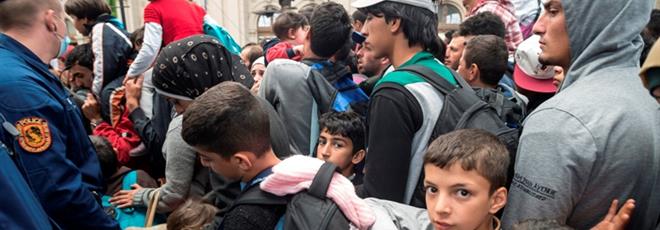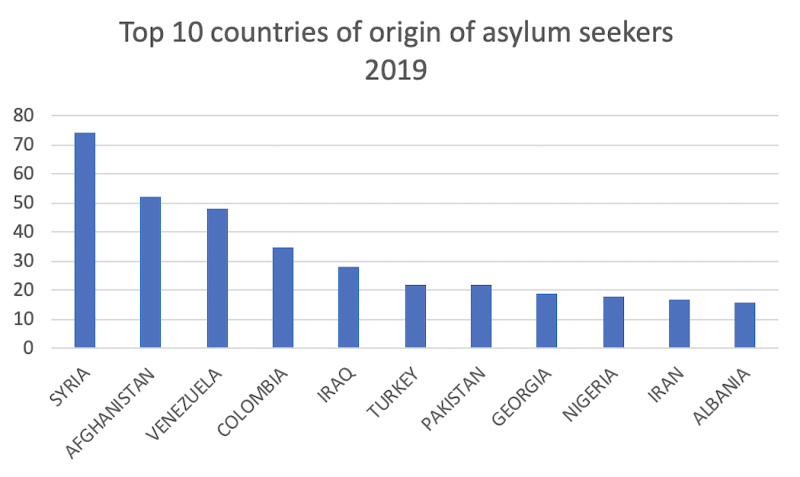
Last updated 24 May 2023
What is EURODAC?
Eurodac is the EU's asylum fingerprint database.
- It contains the fingerprints of all asylum applicants from each Member State and prints from persons apprehended in an irregular border crossing.
- Its primary role is to assist in determining the Member State responsible for examining an asylum application made in the EU and thereby implementing the "Dublin Regulation."
What's so special about EURODAC?
Eurodac was the first biometrically enabled system commissioned by the European Union and the first multinational biometric system globally. Eurodac has been operating continuously since going live on 15 January 2003 and has undergone many expansions and upgrades.
This web dossier will focus on the Eurodac biometric system (European Dactyloscopy System):
- Its origins
- Its evolution
- Some significant facts and figures for 2016-2020.
Cogent Systems, recently acquired by Thales, has been involved in this project since 2002, when it won a contract to supply the Eurodac Automated Fingerprint Identification System (AFIS) - a role Thales Cogent still performs today.
Let's dig in.
Eurodac background
Just two years after the Dublin Convention of 1990, which stated that Asylum applications should be made in the first country of entry into the European Union, Germany set up its fingerprint database of people requesting asylum in different parts of Germany.
So already, at that time, ten years before Eurodac, the concept of "asylum shopping" was identified as a problem that needed to be tackled.
Even then, it was recognised that a pan-European database for asylum seekers was technically possible.
While the European Commission's "Ad Hoc Group on Immigration" was considering whether and how to implement such a system on a cross-EU basis something happened.

Pozzallo, Italy, 2013
The migrant crisis from 1997 to 2017 and on
Throughout 1996, refugees fleeing the war in Iraq arrived in Turkey and attempted to cross into Europe.
Trafficking gangs assisted those seeking a better life in Northern Europe to exit on rubber boats and overcrowded metal hulks – scenes that continue to this day.
Then on 2 November 1997, a boat called the "Hassan Beirut" carrying 769 people, mainly Kurds, ran aground and became stranded off the coast of Italy, many of whom continued their journey through Italy towards Germany.
Crisis talks involving affected member' States sought to find a political solution. And so it was that against this background, the plans for Eurodac took on a second objective – not just to record a request for asylum at the first point of entry but also to register those attempting to enter illegally.
The New Pact on Immigration and Asylum was adopted on 23 September 2020.
Eurodac countries
The Eurodac system enables the comparison of fingerprints of asylum applicants and persons apprehended in connection to an irregular or illegal border crossing in 32 States.
28 EU Member States (including the UK) and 4 Associated Dublin States (Iceland, Norway, Liechtenstein, and Switzerland) use the system.
The new Eurodac Regulation No 603/2013 took effect in July 2015, and national police forces and Europol can now access the system and its fingerprint database to prevent, detect, and investigate the most severe forms of crime, including terrorism.
Why a biometric system?
The goal of Eurodac in the asylum process is to facilitate the application of the Dublin III Regulation.
It provides a mechanism for determining which country is responsible for examining applications for international protection lodged in one of the member states.
To understand why biometrics is critical in identification, please visit our 2022 report on Biometrics for identification and authentication.

Budapest, Hungary – 10 September 2015: Refugees are standing up and waiting to take a train to Vienna under the supervision of Hungarian police. Many refugees are crossing Hungary from Syria, going to other countries of Europe like Germany, Austria, Sweden, or Denmark. They are looking for a better future for their families.
What information does the Eurodac store?
The shared European asylum system stores the minimum amount of information necessary to enforce Dublin III, including:
- ten rolled fingerprints,
- the state sending the data,
- the place and date of the international protection application (if applicable),
- the person's gender, and a reference number.
In response to the migrant crisis, proposals are being considered by the European Parliament to increase the information stored in Eurodac about individuals, such as assisting in reuniting family members.
Let's recap the central technical aspect of identification:
- The system compares fingerprints.
- The system does NOT store biographic data (name, place of birth, date of birth...).
- Facial recognition cannot be applied here because the database does NOT include portraits.

Architecture and capacity
Eurodac underwent major redesigns, first in 2009 and then again in 2015, with "Eurodac Recast," when new workflows were introduced that had to be in place legally at the central and national level by 20 July 2015.
The new architecture was put in place successfully on time, and with it, a new, more accurate matching algorithm was employed.
This graph from EUROSTAT data shows the numbers of people requesting asylum from the system's early days to the present day.
The number of asylum applications grew six-fold between 2005 and 2015, from around 200K to over 1.2 Million per year.
2020 and 2021 asylum application figures
In 2020, the number of first-time asylum applicants decreased to 416,600.
The annual figures reached 648.000 in 2021. 70% are male applicants.
This figure is close to 2019 levels and much lower than the peaks recorded in 2015 and 2016.
Approximately 767,000 applications were awaiting a decision at the end of 2021, similar to a year earlier.
According to EUROSTAT, for 2021, 535,000 first-instance decisions were made by the national authorities of EU Member States.
34 % were positive, that is, granting a type of protection status.

The 2015-2016 peak is now gone.
Whereas around one-third of the applications were repeated applications in the early years, during the worst part of the crisis, almost all were first-time applications.
Germany gets the most, then France, Spain and Italy.
EURODAC 2021 statistics
Of course, the capacity of the system had to be scaled accordingly.
The fingerprint database was initially designed to contain 1.6 million records in 2003.
This capacity was increased in 2009 to 2.8 million records, increased twice more in 2015, first to 3.6 million and then to 5 million, and recently increased to 7 million records, all the while ensuring a high degree of accuracy by providing that each fingerprint record is checked in a one-to-many search.
Likewise, throughput has increased from 500 messages per hour with a 30-minute response time in 2003 to 1,500 messages per hour with a 60-second response time in 2015, making today's system many times larger than in the past.
The Eurodac annual report for 2021, published in December 2022, showed that the number of fingerprint data sets surpassed 5.8 million in 2021.
The system processed 855,478 transactions.
Common European asylum system: a complex workflow
Its unique workflow requirements may be where Eurodac differs most from many other AFIS systems.
They are designed to ensure that only Member States can change or read their records while ensuring that individual freedoms and rights are protected if an individual is granted asylum or citizenship of a Member State.
Achievements and evolution
In conclusion, Eurodac is the largest multi-jurisdictional AFIS in the world, serving 32 countries. It utilises the latest biometric matching technology to support a unique set of business rules, achieving that with very high reliability.
- It has proved to be an essential tool providing fingerprint comparison evidence to help determine the Member State responsible for examining an asylum application in the EU.
- It also sets time limits for transmitting fingerprint data, reducing the time which elapses between the taking and sending of fingerprints to the Central Unit of Eurodac.
- It allows Member States' law enforcement authorities and Europol to compare fingerprints linked to criminal investigations with those in Eurodac.
We see yet more change, including new search types and perhaps face recognition capabilities.
Technical challenges and Thales Cogent's experience
As with Eurodac, Thales' biometric solutions must work in real-life environments on European borders and worldwide – at night, in the dark and the rain and wind at a seaport, sometimes at -20°C or conversely in bright sunlight.
Our expert teams can support you in meeting these real-life challenges.
How can Thales Cogent AFIS solutions better help you?
Thales Cogent Automated Biometric Identification System (CABIS) is used to investigate, identify, and verify civil and border title and law enforcement applications.
Cogent AFISes are already deployed to over 200 applications in over 80 countries.
Thales Solutions can also secure your AFIS system with strong authentication and encryption solutions (HSM and tokenisation), as the company does with India's Aadhaar, the largest biometric database in the world.
If you've something to say on this topic, a question, or have found this article useful, please comment below.
We'd also welcome any suggestions on how it could be improved or proposals for future papers.
We look forward to hearing from you.